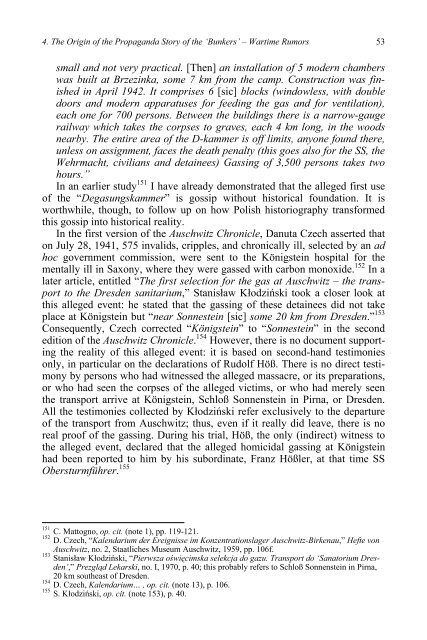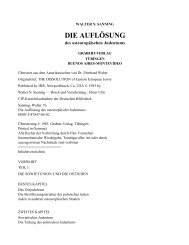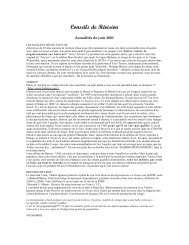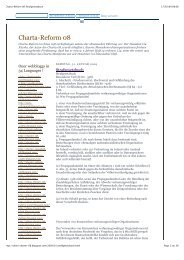You also want an ePaper? Increase the reach of your titles
YUMPU automatically turns print PDFs into web optimized ePapers that Google loves.
4. <strong>The</strong> Origin of the Propaganda Story of the ‘<strong>Bunkers</strong>’ – Wartime Rumors 53<br />
small and not very practical. [<strong>The</strong>n] an installation of 5 modern chambers<br />
was built at Brzezinka, some 7 km from the camp. Construction was finished<br />
in April 1942. It comprises 6 [sic] blocks (windowless, with double<br />
doors and modern apparatuses for feeding the gas and for ventilation),<br />
each one for 700 persons. Between the buildings there is a narrow-gauge<br />
railway which takes the corpses to graves, each 4 km long, in the woods<br />
nearby. <strong>The</strong> entire area of the D-kammer is off limits, anyone found there,<br />
unless on assignment, faces the death penalty (this goes also for the SS, the<br />
Wehrmacht, civilians and detainees) Gassing of 3,500 persons takes two<br />
hours.”<br />
In an earlier study 151 I have already demonstrated that the alleged first use<br />
of the “Degasungskammer” is gossip without historical foundation. It is<br />
worthwhile, though, to follow up on how Polish historiography transformed<br />
this gossip into historical reality.<br />
In the first version of the <strong>Auschwitz</strong> Chronicle, Danuta Czech asserted that<br />
on July 28, 1941, 575 invalids, cripples, and chronically ill, selected by an ad<br />
hoc government commission, were sent to the Königstein hospital for the<br />
mentally ill in Saxony, where they were gassed with carbon monoxide. 152 In a<br />
later article, entitled “<strong>The</strong> first selection for the gas at <strong>Auschwitz</strong> – the transport<br />
to the Dresden sanitarium,” Stanis�aw K�odzi�ski took a closer look at<br />
this alleged event: he stated that the gassing of these detainees did not take<br />
place at Königstein but “near Sonnestein [sic] some 20 km from Dresden.” 153<br />
Consequently, Czech corrected “Königstein” to “Sonnestein” in the second<br />
edition of the <strong>Auschwitz</strong> Chronicle. 154 However, there is no document supporting<br />
the reality of this alleged event: it is based on second-hand testimonies<br />
only, in particular on the declarations of Rudolf Höß. <strong>The</strong>re is no direct testimony<br />
by persons who had witnessed the alleged massacre, or its preparations,<br />
or who had seen the corpses of the alleged victims, or who had merely seen<br />
the transport arrive at Königstein, Schloß Sonnenstein in Pirna, or Dresden.<br />
All the testimonies collected by K�odzi�ski refer exclusively to the departure<br />
of the transport from <strong>Auschwitz</strong>; thus, even if it really did leave, there is no<br />
real proof of the gassing. During his trial, Höß, the only (indirect) witness to<br />
the alleged event, declared that the alleged homicidal gassing at Königstein<br />
had been reported to him by his subordinate, Franz Hößler, at that time SS<br />
Obersturmführer. 155<br />
151 C. Mattogno, op. cit. (note 1), pp. 119-121.<br />
152 D. Czech, “Kalendarium der Ereignisse im Konzentrationslager <strong>Auschwitz</strong>-Birkenau,” Hefte von<br />
<strong>Auschwitz</strong>, no. 2, Staatliches Museum <strong>Auschwitz</strong>, 1959, pp. 106f.<br />
153 Stanis�aw K�odzi�ski, “Pierwsza o�wi�cimska selekcja do gazu. Transport do ‘Sanatorium Dresden’,”<br />
Prezgl�d Lekarski, no. I, 1970, p. 40; this probably refers to Schloß Sonnenstein in Pirna,<br />
20 km southeast of Dresden.<br />
154 D. Czech, Kalendarium… , op. cit. (note 13), p. 106.<br />
155 S. K�odzi�ski, op. cit. (note 153), p. 40.













